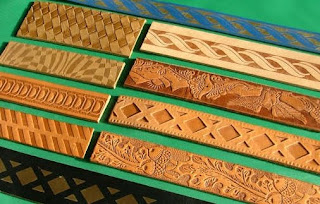
Things you need:
-Vegetable tanned leather or what is called tooling leather to make embossed leather- This type of leather is softer and easy to work with. Most briefcases, saddlebags and leather items are also vegetable tanned leather.
- chisels
-wooden mallet
-Leather scissors
- Leather Dye or Leather Paint
-tracing paper
-hole punch
-leather sealer e.g. Super Shene
Optional:
-pointy stick for burnishing
-stamps and molding tools and stylus
Process:
Select your leather
Usually, tooling is done on "top grain" leather, the type with a smooth side (the natural skin surface). And it is best done on vegetable-tanned leather that has not been oiled or waxed in any way, so it's still pinkish or flesh-coloured.
If you're not sure, as always Test. Wet a corner of it and try making lines with various items like the back of a table knife, the edge of a penny, things like that (not too sharp or pointy). Does it keep the line?
Cut your leather pattern
Standard scissors are not going to cut though anything but the thinnest leathers. Use specially sharpened scissors.
Point that varies among the folks giving tips: Some like to dye the whole piece of leather now. Others wait until it is shaped and carved and then do all the dying at once.
Trace the pattern
First Decide on a design and draw it onto tracing paper.
Position the tracing film onto the right side of the leather. Trace over the pattern with a ballpoint stylus or empty ballpoint pen. Press firmly. Trace all the lines. You may need to dampen the leather a little with a sponge and water if the leather is very hard.
Remove the film. The design should be replicated on the surface of the leather.
Then Trace over the outline with a knife.
You may also wish to Punch the holes or slots for sewing now.
Dampen the leather
(Here is where opinions vary from folks)
Smaller projects you can use wet sponge or wet rag.
That's why you soak the leather through and leave it for 30 minutes (less for smaller pieces) , laying on a flat surface and then go tool it. That way it will still hold the form when you mold it and it will hold the design but not be too waterlogged.
Too wet it does have a tendency to revert to "flesh" so it might be a little too malleable. Let dry a bit.
Warnings:
- If you've soaked the whole piece, don't let the leather dry out while you're working with it. (it will shrink) Later you will let it dry by stretching it over your molded shape.
Burnish the leather - optional
Burnish the leather with a metal burnishing tool or a wooden pointy stick.
This will help the longevity of the pattern.
Carve and stamp
Carve your design into the leather without cutting it. (Cut are only used very sparely.)
You will to use the chisels and a sharp knife to shape your design but try not to cut into the leather. A stylus will allow you to draw lines.
Some people suggest to use stamps and various molding tools but you can get away with chisels and knifes.
The stamps are hammered into the leather with a mallet. A rawhide mallet is best but you can also use plastic. You do not want to use a metal hammer. That provides too much pressure.
You must be careful when you are tooling a large section of leather. All that pounding and cutting and wetting and pounding can end up stretching your piece of leather so that it no longer correctly fits. Tape or glue something to the back side of the leather to keep it from 'growing' out of size. Most basic leather books mention this but time and time again. people run into problems with fit after the careful work in the beginning.
Dye the leather
After you've carved your designs, you may wish to dye the pattern you have just tooled or, it you have not yet dyed the whole hide, now is the time.
Be use to wear gloves and protect your surfaces.
Practice first so that you can see how the dye flows and absorbers into the leather. If you dye before the pieces are cut, then your cut edges will show a lighter/undyed colour.
Dyed leather will tool differently and, if you're going to carve it, the gouge will show a different colour than your dyed surface. However, you might like that look, so try things out on a test-dyed scrap first.
When doing a large surface, use long smooth strokes. Even better, if you've got it, use an air brush.
Recommended dyes
Finish the edges
Smooth and slick your edges to a polish. Edges that are not finished over time will look frayed and worn.
Mold It
If you are doing something that needs shaping, stretch the leather over the mold and lace it in place. This could be your cardboard and duct tape mold. It could be a paint can for the vambraces... etc.
You may do more cutting and punching at this point.
Additional painting of the design may be done at this point.
Paint recommendations
- Cova Colour paints
- Tamiya acrylic paints
Let dry at least 24 hours.
Seal it
When you are all done, the leather needs to be sealed to protect your work and keep it from the damp.






















































